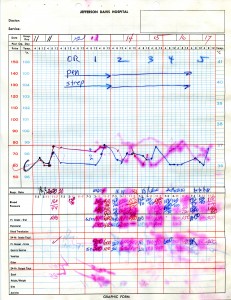
Medical Record, 1963. Texas Medical Center Library Archives, IC18 Harris County Hospital District, box 8D, Folder 51477
Guest post by Olivia Banner
It may seem obvious that we’ve made great progress in keeping medical records since 1900. In the early nineteenth century, prior to the rise of methods for analyzing the body’s chemical properties (blood tests, e.g.), doctors relied on hands-on methods like measuring pulse and listening to breath to figure out what was wrong with patients, and they recorded little about their consultations. Doctors’ logbooks were more likely to note what a patient owed them than any relevant medical information. In the late nineteenth century, when physicians became increasingly dependent on analyzing data about the body and when early hospitals began to keep records, there were no standards in place to dictate what information about the patient to record. The information that was recorded and the form the record took were up to the discretion of individual physicians. The result? It was impossible for doctors to compare cases in a meaningful way, nor was there any way to trace back how a doctor arrived at a diagnosis.
In the early twentieth-century, the modern hospital emerged, and with it medical education programs. These two developments made standardized records a necessity. Add to these factors the 1960 integration of computers, and all the conditions were in place to produce today’s medical record. And how necessary that medical record is to modern medical practice cannot be overemphasized. It enables teaching students how to interpret patient information; tracking a patient over time; aggregating data for the purposes of better understanding health and illness — all of which seem to represent significant progress over what could come out of the spotty and random records of the nineteenth century. Electronic medical records seem to allow us to record a patient’s facts in an easily accessible and flexible format, providing us with the definitive, accurate, and objective record of the case.
Yet there’s another way of looking at the long history of medical records, and that’s to explore how patients have recorded their interactions with medicine. This history, contained in journal entries, memoirs, and creative works, does not as easily fit into a narrative of progress. These “records” instead suggest that when patients are unhappy with medical professionals, it is because their own understandings of their conditions — their subjective accounts — have been rejected in favor of the objective truth that numerical measures are thought to provide.
To address this complex, and often overlooked, history, I’m creating a digital project that will allow users to explore the history of medical records from both sides. “Visualizing the Patient, from the Past to the Future” (which will reside at Connexions) provides a historical overview of materials by which doctors, hospitals, and patients have recorded their interactions. What is lost, and what is gained, in the move to electronic records? Will there be a way for patients’ narratives to be recorded in these records? As users view the materials and ponder these questions, they can use their answers to consider the best form for electronic medical records, the best ways they can be used within the clinical setting, and their possible limitations.
